
* In the 1960s there was an international competition to build a supersonic transport (SST), which resulted in the development of two supersonic airliners, the Anglo-French "Concorde" and the Soviet Tupolev "Tu-144". Although the SST was seen as the way of the future, that wasn't how things actually turned out. This document provides a history of the rise and fall of the supersonic transport.
* With the push towards supersonic combat aircraft during the 1950s, aircraft manufacturers began to think about developing a supersonic airliner, what would eventually become known as a "supersonic transport (SST)". In 1961, Douglas Aircraft publicized a design study for an SST that would be capable of flying at Mach 3 at 21,350 meters (71,000 feet) and could be flying by 1970. Douglas forecast a market for hundreds of such machines.
At the time, such a forecast seemed realistic. During the 1950s, commercial air transport had made a radical shift from piston-powered airliners to the new jetliners like the Boeing 707. Going to an SST was simply the next logical step, and there was an economic rationale to it: move passengers faster, that meant more utilization of an airliner. In fact, as discussed in the next section, Europe was moving even faster down this road than the US. In 1962 the British and French signed an agreement to actually build an SST, the "Concorde". With the Europeans committed to the SST, of course the Americans had to follow, and the US Federal Aviation Administration (FAA) set up a competition for an SST that would be faster, bigger, and better than the Concorde.
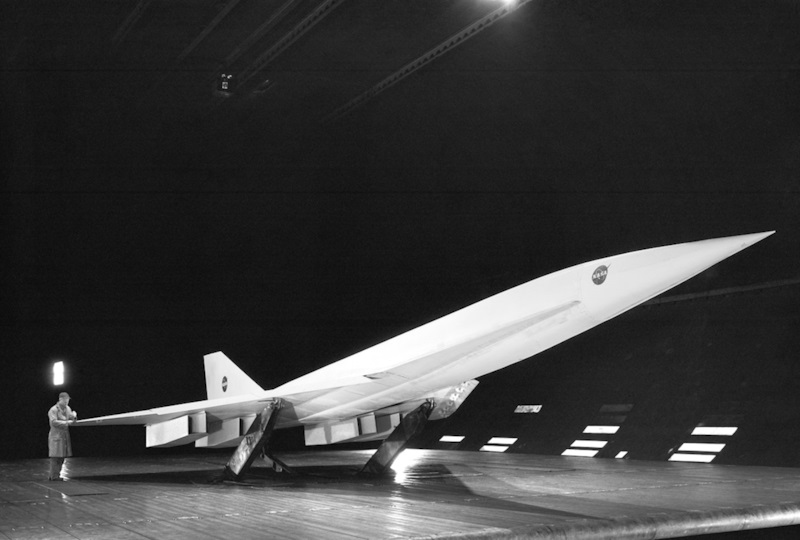
In 1964, SST proposals from North American, Lockheed, and Boeing were selected as finalists. Although North American had built the two XB-70 Valkyrie experimental Mach 3 bombers, which had a configuration and performance similar to that of an SST and were used as testbeds for SST concepts, the company was eliminated from the competition in 1966. Lockheed proposed the "L-2000", a double-delta machine with a capacity of 220 passengers, while Boeing proposed the "Model 2707", the name obviously implying a Mach 2 aircraft that would be as significant as the classic Boeing 707.
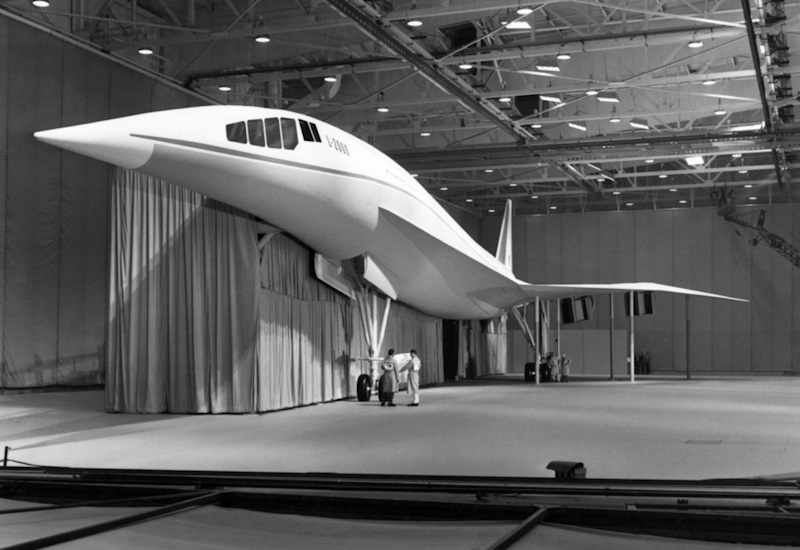
Boeing won the contract on 1 May 1967, with two prototypes to be built. The 2707 was to be a large aircraft, about 90 meters (300 feet) long, with a maximum load of 350 passengers. It would be able to cruise at Mach 2.7 over a range of 6,440 kilometers (4,000 miles) with 313 passengers. At first, the 2707 was envisioned as fitted with variable geometry "swing wings" to permit efficient high-speed flight -- with the wings swept back -- and good low-speed handling -- with the wings extended.
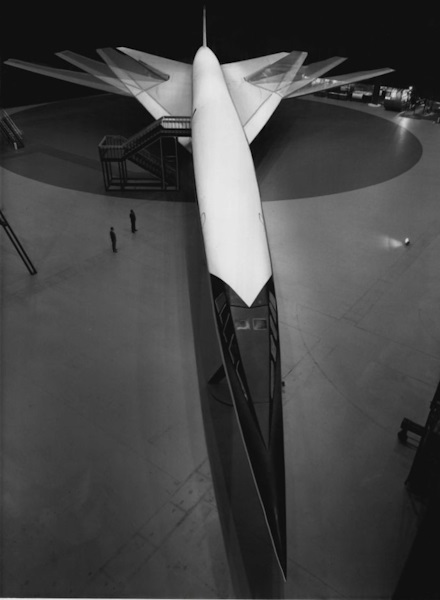
Powerplants were to be four General Electric GE-J5P afterburning low-bypass fan jet engines, derived from the GE J93 engines used on the XB-70, with a maximum afterburning thrust of 267 kN (27,200 kgp / 60,000 lbf) each. The engines were to be fitted into separate nacelles under the wing. Further work on the design demonstrated that the swing-wing configuration was simply too heavy, and so Boeing engineers came up with a new design, the "2707-300", that had fixed wings.
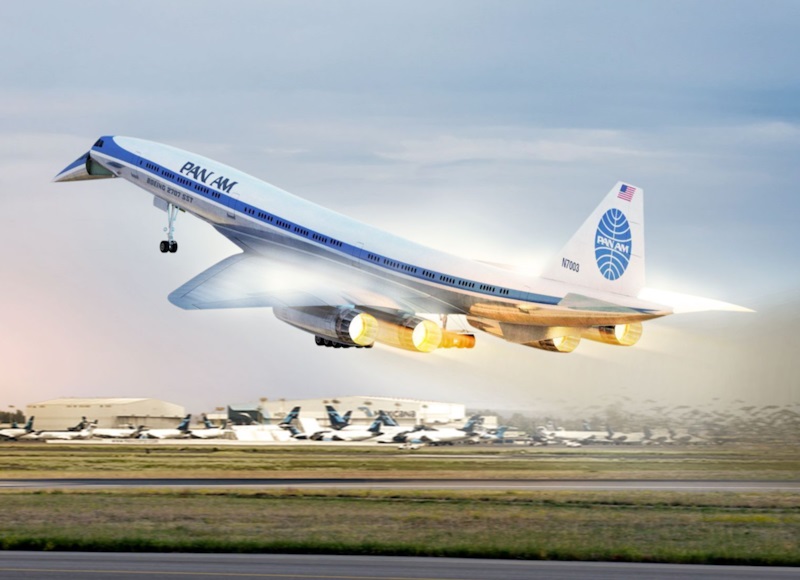
However, America in the late 1960s was all but overwhelmed by social upheaval that involved questioning the need to come up with something bigger and better, as well as much increased concerns over the environment. Critics massed against the SST, voicing worries about its sonic booms and the possible effects of its high-altitude cruise on the ozone layer. The US Congress finally zeroed funds for the program on 24 March 1971 after the expenditure of about a billion USD on the project. There were 121 orders on the books for the aircraft when it was canceled.
SST advocates were dismayed, but later events would prove that -- even ignoring the arguments over environmental issues -- the SST was simply not a good business proposition, and proceeding with the project would have been a big mistake. Enthusiasm for SSTs among US aircraft manufacturers faded out.
BACK_TO_TOP* As mentioned, the British and French were actually ahead of the US on SST plans. In 1955, officials of the British aviation industry and British government agencies had discussions on the notion of an SST, leading to the formation of the "Supersonic Transport Aircraft Committee (STAC)" in 1956. STAC conducted a series of design studies, leading to the Bristol company's "Bristol 198", which was a slim, delta-winged machine with eight turbojet engines, designed to cross the Atlantic at Mach 2. This evolved into the somewhat less ambitious "Bristol 223", which had four engines and 110 seats.
In the meantime, the French had been conducting roughly similar studies, with Sud-Aviation of France coming up with a design surprisingly similar to the Bristol 223, named the "Super Caravelle", after the innovative Caravelle twinjet airliner developed by Sud-Aviation in the 1950s. Given the similarity in the designs and the high cost of developing an SST, British and French government and industry officials began talks in September 1961 to see if the two nations could join hands for the effort.
After extensive discussions, on 29 November 1962, the British and French governments signed a collaborative agreement to develop an Anglo-French SST, which became the "Concorde". It was to be built by the British Aircraft Corporation (BAC), into which Bristol had been absorbed in the meantime, and Rolls-Royce in the UK; along with Sud-Aviation and the SNECMA engine firm in France. The original plan was to build a 100-seat long-range aircraft for transoceanic operations and a 90-seat mid-range aircraft for continental flights. In fact, the mid-range aircraft would never be built.
The initial contract specified the construction of two flight prototypes, two static-test prototypes, and two preproduction aircraft. BAC was responsible for development and production of:
Sud-Aviation was responsible for development and production of:
Design of the automatic flight control system was subcontracted by Aerospatiale to Marconi (now BAE Systems Electronics) in Britain and SFENA (now Thales) in France. Final assembly of British Concordes was at Filton and of French Concordes was at Toulouse.
Airlines began to place options for purchase of Concordes in June 1963, with service deliveries originally expected to begin in 1968. That proved a bit over-optimistic. Prototype construction began in February 1965. The initial "001" prototype was rolled out at Toulouse on 11 December 1967, but it didn't perform its first flight for another 15 months, finally taking to the air on 2 March 1969, with a flight crew consisting of Andre Turcat, Jacques Guignard, Michel Retif, and Henri Perrier. The first flight of the "002" prototype took place from Filton on 9 April 1969. Flight trials showed the design to be workable, though it was such a "bleeding edge" machine that there were a lot of bugs to be worked out. First supersonic flight by 001 wasn't until 1 October 1969, and its first Mach 2 flight wasn't until 4 November 1970.
The first preproduction machine, "101", performed its initial flight from Toulouse on 17 December 1971, followed by the second, "102", which performed its initial flight from Filton on 10 January 1973. The first French production aircraft, "201", performed its initial flight from Toulouse on 6 December 1973, by which time Sud-Aviation had been absorbed into Aerospatiale. The first British production machine, "202", performed its initial flight from Filton on 13 February 1974, both machines well exceeding Mach 1 on their first flight. These two production machines were used for flight test and never entered commercial service.
14 more production machines were built, the last performing its initial flight on 20 April 1979, with seven Concordes going into service with British Airways and seven into service with Air France. The Concorde received French certification for passenger operations on 13 October 1975, followed by British certification on 5 December 1975. Both British Airways and Air France began commercial flights on 21 January 1976. The Concorde was finally in service.
There has never been a full accounting of how much it cost the British and French governments to get it there, but one modern estimate is about 1.1 billion pounds in 1976 values, or over 10 billion pounds / $12.5 billion USD in 2020 values. Of the 20 Concordes built, six never carried any paying passengers. In fact, only nine of the production machines were sold at "list value". The other five were simply given to British Airways and Air France for literally pocket change, apparently just to get them out of the factories.
* The initial routes were London to Bahrain, and Paris to Rio de Janiero via Dakar. Service to Washington DC began on 24 May 1976, followed by flights to New York City in December 1977. Other routes were added later, and there were also large numbers of charter flights, conducted mostly by British Airways.
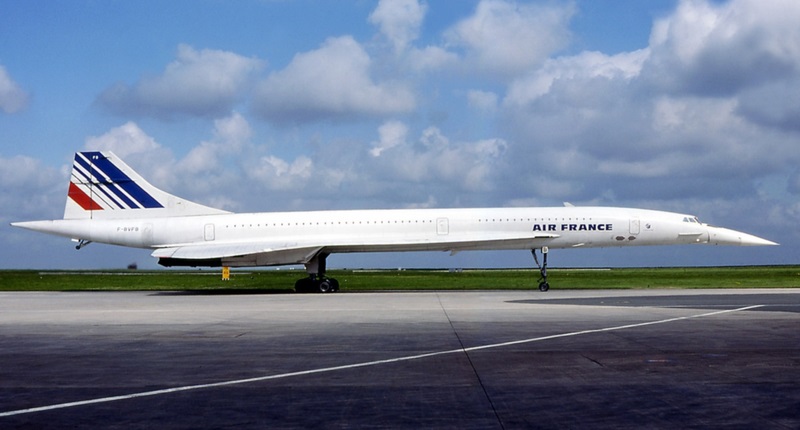
The manufacturers had obtained options for 78 Concordes, most prominently from the US carrier Pan-American -- but by the time the aircraft was ready to enter service, interest had evaporated. Sonic boom ensured that it could not be operated on overland routes, a consideration that had helped kill off the mid-range Concorde, and even on the trans-Atlantic route the thundering noise of the four Olympus engines led to restrictions on night flights to New York City, cutting the aircraft's utilization on the prime trans-Atlantic route in half.
The worst problem, however, was that the 1970s were characterized by rising fuel prices that rendered the thirsty SST clearly uneconomical to operate. It required 3.5 times more fuel to carry a single passenger in the Concorde than in a Boeing 747, with its modern, fuel-efficient high-bypass turbofans. The Americans had been sensible to kill off the Boeing 2707-300: even if the environmental threat of the machine had been greatly exaggerated, the 2707-300 would have never paid itself off.
There was some muttering in Britain and France that Pan-Am's cancellation of its Concorde orders and the restrictions on night flights into New York City were part of a jealous American conspiracy to kill the Concorde -- but Pan-Am brass had simply done the numbers, and wisely decided the Concorde didn't make business sense. Pan Am had analyzed use of the Concorde on trans-Pacific flights, such as from San Francisco to Tokyo, and quickly realized that its relatively limited range meant refueling stops in Honolulu and Wake Island. A Boeing 747 could make the long-haul trip without any stops, and in fact would get to Tokyo faster than the Concorde under such circumstances. First-class customers would also have a much more comfortable ride on the 747.
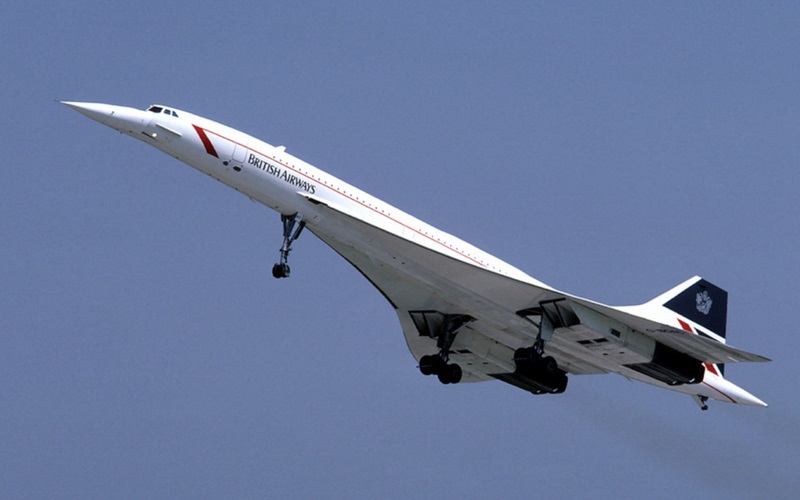
The Port Authority of New York & New Jersey was mainly worried about irate townspeople raising hell over noisy Concordes waking them up in the middle of the night. These "townspeople" were assertive New Yorkers, after all, and they had been pressuring the Port Authority with various complaints, justified or not, about aircraft operations from Idlewild / Kennedy International Airport since 1958. There were few jetliners noisier than the Concorde; in another unfortunate irony, the new high-bypass turbofans used by airliners such as the 747 were not only much more fuel-efficient than older engines, they were much quieter, making the Concorde look that much worse in comparison.
Some Europeans were not surprised by the Concorde's problems. In 1966, Henri Ziegler, then head of Breguet Aviation of France, commented with classic French directness: "Concorde is a typical example of a prestige program hastily launched without the benefit of detailed specifications studied in partnership with airlines."
Ziegler would soon become the first boss of Airbus Industries, which would rise to effectively challenge mighty Boeing for the world's airliner market. Airbus was established on the basis of such consultations between aircraft manufacturers and airlines. The Concorde program would have important lessons for Airbus, if mostly along the lines of how not to do things. The full duplication of Concorde production lines in the UK and France was seen as a particular blunder that substantially increased program costs. Airbus took the more sensible strategy of having different elements built in different countries, then transporting them to Toulouse for final assembly and flight check.
* The Concorde was a long, dartlike machine with a low-mounted delta wing and four Orpheus afterburning low-bypass fan jets, with two mounted in a pod under each wing. It was mostly made of aircraft aluminum alloys plus some steel assemblies, but featured selective high-temperature elements fabricated from Inconel nickel alloy. It was designed for a cruise speed of Mach 2.2. Higher speeds would have required much more extensive use of titanium and other high-temperature materials.
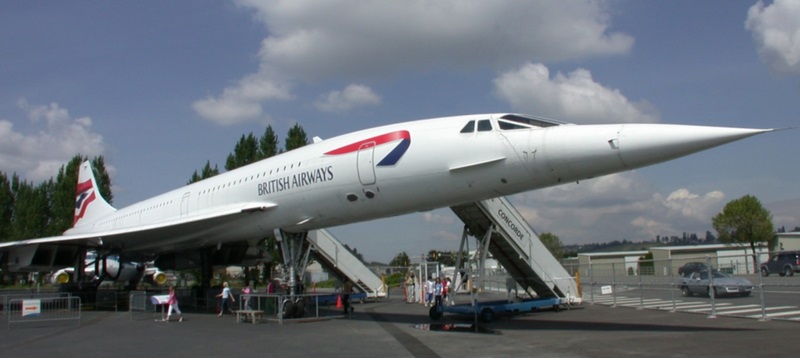
The pilot and copilot sat side-by-side, with a flight engineer behind on the right, and provision for a fourth seat. The crew flew the aircraft with an automatic flight control system, guiding their flight with an inertial navigation system backed up by radio navigation systems. Avionics also included a suite of radios, as well as a flight data recorder.
The nose was drooped hydraulically to improve the forward view during take-off and landing. A retractable transparent visor covered the forward windscreen during supersonic cruise flight. There were short "strake" flight surfaces beneath the cockpit, just behind the drooping nose, apparently to help ensure airflow over the tailfin when the aircraft was flying at high angles of attack.
Each of the four Rolls-Royce / SNECMA Olympus 593 Mark 10 engines was rated at 169.3 kN (17,255 kgp / 38,050 lbf) thrust with 17% afterburning. The engine inlets had electrical de-icing, variable ramps on top of the inlet throat, and auxiliary inlet / outlet doors on the bottom. Each engine was fitted with a bucket-style variable exhaust / thrust reverser. The Olympus had been originally developed in a non-afterburning form for the Avro Vulcan bomber, and a Vulcan had been used in trials of the Concorde engines. The Concorde used afterburner to get off the ground and up to operating speed / altitude, and then cruised at Mach 2 on dry (non-afterburning) thrust. It was one of the first, possibly the first, operational aircraft to actually cruise continuously at supersonic speeds. Interestingly, at subsonic speeds the aircraft was inefficient, requiring high engine power that drained the fuel tanks rapidly.
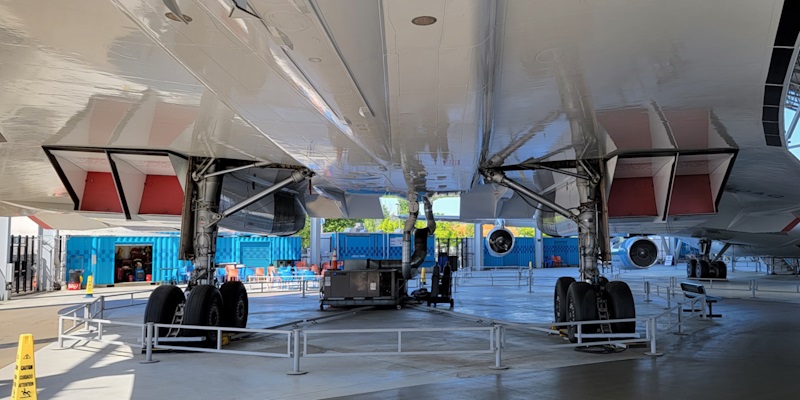
Total fuel capacity was 119,786 liters (26,350 Imperial gallons / 31,645 US gallons), with four tanks in the fuselage and five in each wing. Fuel trim was maintained by an automatic system that shuttled fuel between trim tanks, one in the tail and a set in the forward section of the wings, to maintain the proper center of gravity in different flight phases.
The wing had an elegantly curved "ogival" form factor, and a chord-to-thickness ratio of 3% at the wing root, and featured six hydraulically-operated elevon control surfaces on each wing, organized in pairs. The tailfin featured a two-section rudder, apparently to provide redundancy and improve safety. The Concorde had tricycle landing gear, with a twin-wheel steerable nosewheel retracting forward, and four-wheel bogies in a 2-by-2 arrangement for the main gear, retracting inward. The landing gear featured carbon disk brakes and an antiskid system. There was a retractable tail bumper wheel to protect the rear of the aircraft on take-off and landing.
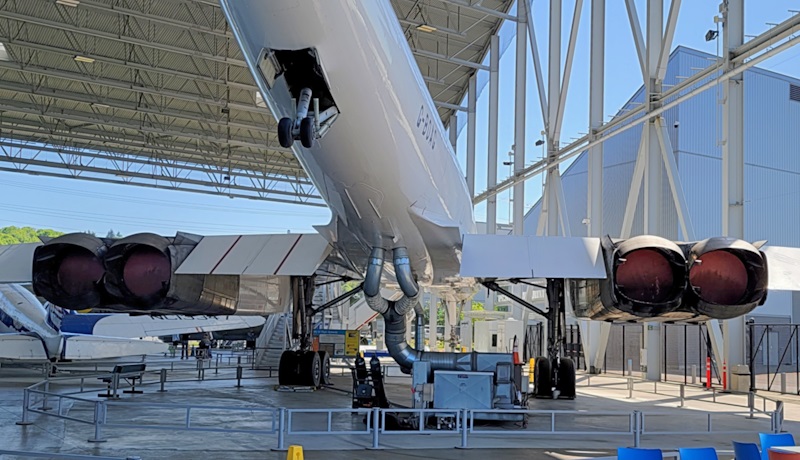
Maximum capacity was in principle 144 passengers with a high-density seating layout -- but in practice seating was not more than 128, and usually more like 100. Of course, all accommodations were pressurized and climate-controlled; the soundproofing was excellent, resulting in a smooth and quiet ride. There were toilets at the front and middle of the fuselage, and galleys front and back. Customer service on the flights placed substantial demands on the stewards and stewardesses because at cruise speed, the Concorde would reach the limit of its range in three hours.
___________________________________________________________________
AEROSPATIALE-BAC CONCORDE:
___________________________________________________________________
wingspan:
25.56 meters (83 feet 10 inches)
wing area:
385.25 sq_meters (3,856 sq_feet)
length:
62.10 meters (203 feet 9 inches)
height:
11.40 meters (37 feet 5 inches)
empty weight:
78,700 kilograms (173,500 pounds)
MTO weight:
185,065 kilograms (408,000 pounds)
max cruise speed:
2,180 KPH (1,345 MPH / 1,175 KT)
service ceiling:
18,300 meters (60,000 feet)
range:
6,580 kilometers (4,090 MI / 3,550 NMI)
___________________________________________________________________
The two prototypes had been slightly shorter and had been fitted with less powerful Olympus engines. A "Concorde B" was considered, with airframe changes -- including leading edge slats, wingtip extensions, modified control surfaces, and 4.8% more fuel capacity -- plus significantly improved Olympus engines that provided incrementally better fuel economy, allowing a nonstop trans-Pacific flight, and greater dry thrust, allowing take-offs without noisy afterburner. However, the Concorde B still couldn't operate over land, and it still couldn't compete with modern subsonic jetliners in terms of fuel economy. It never got off the drawing board.
* On 25 July 2000, an Air France Concorde was departing from the Charles de Gaulle airport outside Paris, when one of its tires hit a piece of metal lying on the runway. The tire disintegrated; a piece of rubber spun off and hit the aircraft, setting up a shockwave that ruptured a fuel tank. The airliner went down in flames to crash near the town of Gonesse, killing all 109 people aboard and four people who had the bad luck to be in the impact area. All 12 surviving Concordes were immediately grounded pending an investigation.
Safety modifications were made to all seven British Airways and all five surviving Air France Concordes. The bottom of the fuel tanks, except those in the wing outboard of the engines, was fitted with flexible Kevlar-rubber liners to provide them with a limited "self sealing" capability; minor safety modifications were made to some electrical systems; and new "no blowout" tires developed by Michelin were fitted. British Airways also implemented a previously planned update program to fit their seven aircraft with new passenger accommodations.
The Concorde returned to flight status on 7 November 2001 -- but it was a hollow triumph. The economics of even operating the Concorde, let alone developing it, were marginal, and with the economic slump of the early 21st century both Air France and British Airways were losing money on Concorde flights. In the spring of 2003, Air France announced that they would cease Concorde operations as of 31 May 2003, while British Airways would cease flights by the end of October 2003. The announcement led to unprecedented levels of passenger bookings for the final flights.
Air France's most worked aircraft, named the "Fox Alpha", had performed 5,845 flights and accumulated 17,723 flight hours. One Air France technical manager claimed that the British and French Concorde fleets had accumulated more supersonic time than all the military aircraft ever built. That may be an exaggeration -- how anyone could compile and validate such a statistic is a good question -- but it does illustrate the unique capabilities of the aircraft. Interestingly, spares were never a problem, despite the age and small numbers of Concordes, since large inventories of parts had been stockpiled for the machines.
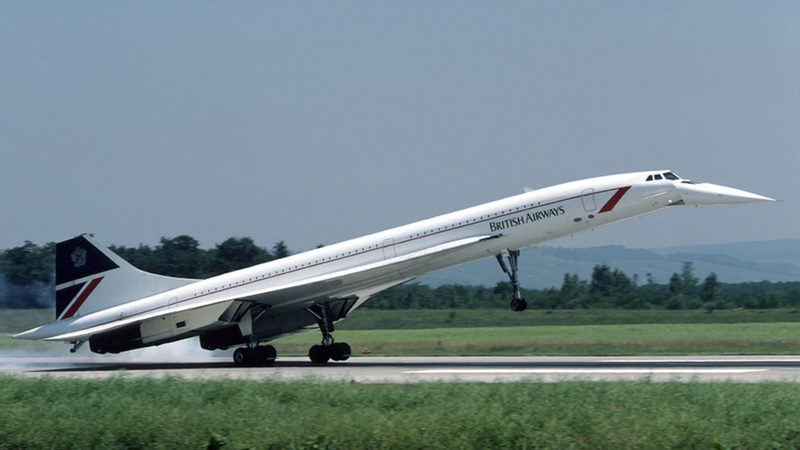
It was a sign of the Concorde's mystique that the aircraft were in great demand as museum pieces. Air France CEO Jean-Cyril Spinetta said: "We had more requests for donations than we have aircraft." One ended up on display at the Charles de Gaulle Airport near Paris, while another found a home at the US National Air & Space Museum's Steven F. Udvar-Hazy Center at Dulles International Airport in Washington DC. In something of an irony, one of the British Concordes was given to the Museum of Flight at Boeing Field in Seattle, Washington.
The last operational flight of the Concorde was on 24 October 2003, with a British Airways machine flying from New York to London. British aviation enthusiasts flocked to Heathrow to see the arrival. As it taxied off the runway, it passed under an honorary "water arch" created by the water cannons of two fire engines. During the type's lifetime, Air France had racked up 105,000 hours of commercial flight operations with the Concorde, while British Airways had run up a tally of 150,000 hours. Concorde admirers like to say the type operated at a profit through all its flight career -- but that could only be so if the development costs were struck off.
On 25 November 2003, a Concorde that had landed at Kennedy on 10 November was hauled up the Hudson River on a barge past the Statue of Liberty for display at New York City's Intrepid Air Museum. New Yorkers turned out along the waterfront to greet the arrival.
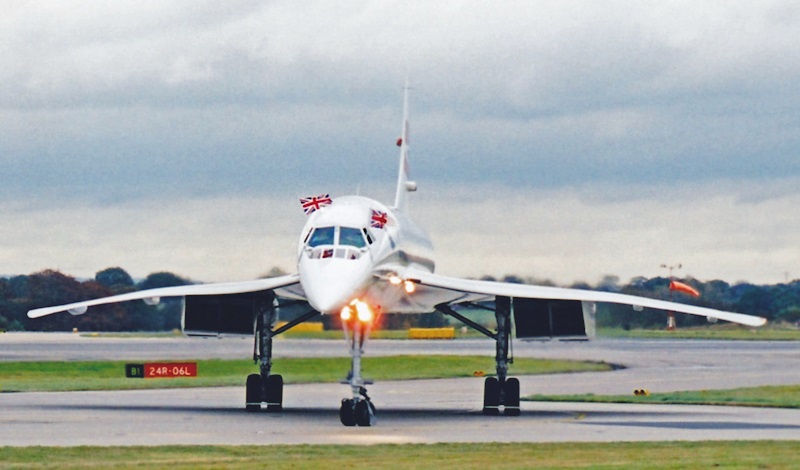
The very last flight of a Concorde was on 26 November 2003, when a British Airways Concorde took off from Heathrow, performed a ceremonial loop over the Bay of Biscay and then flew back to Filton, where it was to be put on display. The aircraft performed a "photo op" by flying over the famous chain suspension bridge at Clifton, not far from Filton; as the crew taxied the airliner after landing, they hung Union Jacks out the windows and raised the nose up and down to please the crowd of 20,000 that was on hand. When the Olympus engines were shut down for the very last time, the crew got out and handed over the flight logs to HRH Prince Andrew in a formal ceremony.
BACK_TO_TOP* Of course, during the 1960s the Soviets and the West were in competition, and anything spectacular the West wanted to do, the Soviets wanted to do as well. That included an SST.
The Soviet Tupolev design bureau developed the USSR's answer to the Concorde, the Tupolev "Tu-144", also known by the NATO reporting name "Charger". The Tu-144 prototype performed its first flight on 31 December 1968, with test pilot Eduard Elyan at the controls, beating the Concorde by three months. 17 Tu-144s were built, the last one coming off the production line in 1981. This sum included one prototype; two "Tu-144C" preproduction aircraft; and 14 full production machines, including nine initial-production "Tu-144S" aircraft, and five final production "Tu-144Ds" with improved engines.
* The Tu-144 got off to a terrible start, the second Tu-144C preproduction machine breaking up in midair during a demonstration at the Paris Air Show on 9 June 1973, the debris falling into the village of Goussainville. All six crew in the aircraft, plus eight French citizens on the ground, were killed; 15 houses were destroyed and 60 people injured. Since the initial reaction of the crowd watching the accident was that hundreds of people were likely to have been killed, there was some small relief that the casualties were relatively light. The entire ghastly accident was captured on film.
The details of the incident remain murky. The Concorde had put on a flight display just before the take-off of the Tu-144, and a French air force Dassault Mirage fighter was in the air, observing the two aircraft. The Concorde crew had been alerted that the fighter was in the area, but the Tu-144 crew had not. The speculation is that the pilot of the Tu-144, M.V. Kozlov, saw the Mirage shadowing him. Although the Mirage was keeping a safe distance, Kozlov might have been surprised and nosed the Tu-144 down sharply to avoid a collision. Whatever the reason for the nosedive, it flamed out all of the engines. Kozlov put the aircraft into a dive so he could get a relight, then overstressed the airframe when he tried to pull out.
This scenario remains speculation. Other scenarios suggest that Kozlov was trying too hard to outperform the Concorde, and took the machine out of its envelope. After a year's investigation, the French and Soviet governments issued a brief statement saying that the cause of the accident could not be determined. Some suspect a cover-up, but it is impossible to make a credible judgement given the muddy trail -- the people who could have explained exactly what had happened weren't among the living any more.
* The Tu-144 resembled the Concorde, sometimes being called the "Concordski", and there were accusations that it was a copy. Many Western observers pointed out that there were also similarities between the Concorde and American SST proposals, and there was no reason to believe the resemblances between the Concorde and the Tu-144 were much more than a matter of the normal influence of published design concepts on organizations -- as well as "convergent evolution", or the simple fact that two machines designed separately to do the same task may out of simple necessity look alike.
The truth was muddier. Building an SST was an enormous design challenge for the Soviet Union. As a matter of national prestige, it had to be done, with the Soviet aircraft doing it first, and since the USSR was behind the West's learning curve, the logical thing to do was steal. An organization was established to collect and analyze open-source material on SSTs from the West, while Soviet intelligence targeted the Concorde effort for penetration.
In 1964, French counterintelligence got wise to the game, sending out an alert to relevant organizations to watch out for snoops and to be careful about releases of information. The French began to keep tabs on Sergei Pavlov, the head of the Paris office of Aeroflot, whose official job gave him legitimate reasons for obtaining information from the French aviation industry, and put him in an excellent position to spy on the Concorde effort. Pavlov was not aware that French counterintelligence was on to him, and so the French fed him misinformation to send Soviet research efforts down dead ends. Eventually, on 1 February 1965, the French arrested him while he was going to a lunch date with a contact, and found that he had plans for the Concorde's landing gear in his briefcase. Pavlov was thrown out of the country.
However, the Soviets had another agent, Sergei Fabiew, collecting intelligence on the Concorde effort, and French counterintelligence knew nothing about him. His cover was finally blown in 1977 by a Soviet defector, leading to Fabiew's arrest. Fabiew had been highly productive up to that time. In the documents seized from him, investigators found a congratulations from Moscow for passing on a complete set of Concorde blueprints.
* Although the Soviets did obtain considerable useful intelligence on the Concorde, they were traditionally willing to use their own ideas or stolen ideas on the basis of which seemed the best. They could make good use of fundamental research obtained from the Concorde program to avoid dead ends and get a leg up, and they could leverage designs of Concorde subsystems to cut the time needed to build subsystems for the Tu-144.
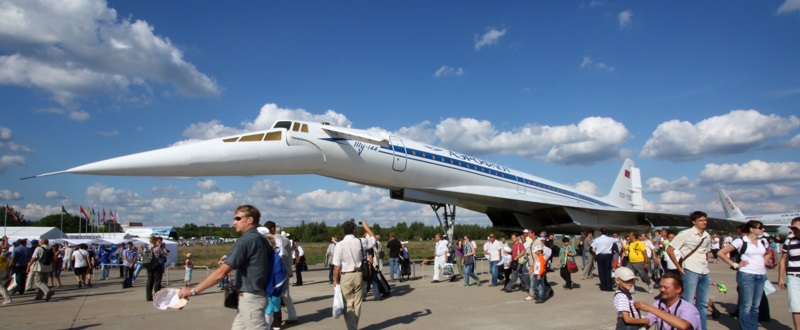
In other words, the Tu-144 was still by no means a straight copy of the Concorde. The general configuration of the two aircraft was similar, both being dartlike delta-type aircraft with four afterburning engines paired in two nacelles; a drooping nose to permit better view on take-off and landing; and a flight crew of three. Both machines were mostly built of conventional aircraft alloys. However, there were many differences in detail:
The Tu-144 was powered by four Kuznetsov NK-144 afterburning low-bypass fan jets with 196.2 kN (20,000 kgp / 44,100 lbf) afterburning thrust each. The engines had separate inlet ducts in each nacelle and variable ramps in the inlets. The Tu-144D, which performed its first flight in 1978, was fitted with Kolesov RD-36-51 engines that featured much improved fuel economy and apparently uprated thrust. Production machines seem to have had thrust reversers, but some sources claim early machines used drag parachutes instead.
___________________________________________________________________
TUPOLEV TU-144:
___________________________________________________________________
wingspan:
28.80 meters (94 feet 6 inches)
wing area:
438.00 sq_meters (4,715 sq_feet)
length:
65.70 meters (215 feet 6 inches)
height:
12.85 meters (42 feet 2 inches)
empty weight:
85,000 kilograms (187,395 pounds)
MTO weight:
180,000 kilograms (396,830 pounds)
max cruise speed:
2,500 KPH (1,555 MPH / 1,350 KT)
service ceiling:
18,300 meters (60,000 feet)
range:
6,500 kilometers (4,040 MI / 3,515 NMI)
___________________________________________________________________
The Tu-144 prototype was a bit shorter and had ejection seats, though production aircraft did not, and the prototype also lacked the retractable canards. The engines fitted to the prototype had a lower thrust rating and were fitted into a single engine box, not a split box as in the production machines. Pictures of the preproduction machines show them to have had a production configuration, though no doubt they differed in minor details.
* The Tu-144 was not put into service until 26 December 1976, and then only for cargo and mail transport by Aeroflot between Moscow and Alma Ata, Kazakhstan, for operational evaluation. The Tu-144 didn't begin passenger service until 1 November 1977, and then apparently it was a cramped and uncomfortably noisy ride. Operating costs were unsurprisingly high, and it seems the aircraft's reliability left something to be desired -- which would not be surprising given its "bleeding edge" nature, and particularly the haste in which it was developed.
The next year, on 23 May 1978, the first Tu-144D caught fire, had to perform an emergency landing, and was destroyed with some fatalities. The program never recovered. The Tu-144 only performed a total of 102 passenger-carrying flights. Some flight research was performed on two of the aircraft up to 1990, when the Tu-144 was finally grounded. Tupolev conducted design studies for a follow-on, the "Tu-244", but it was canceled in 1993.
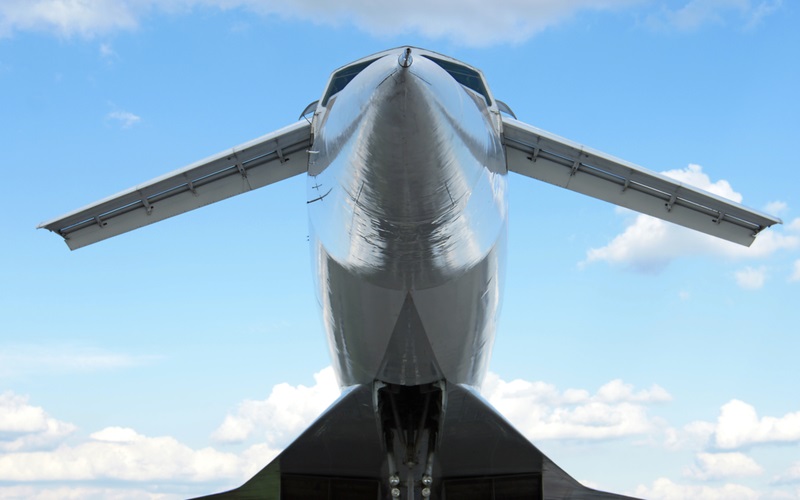
* That was not quite the end of the story. As discussed below, even though the Concorde and Tu-144 were clearly not money-making propositions, interest in building improved SSTs lingered on through the 1980s and 1990s. The US National Aeronautics & Space Administration (NASA) conducted studies on such aircraft, and in June 1993 officials of the Tupolev organization met with NASA officials at the Paris Air Show to discuss pulling one of the Tu-144s out of mothballs to be used as an experimental platform for improved SST design. The meeting had been arranged by British intermediaries.
In October 1993, the Russians and Americans announced that they would conduct a joint advanced SST research effort. The program was formalized in an agreement signed by American Vice-President Al Gore and Russian Prime Minister Viktor Chernomyrdin at Vancouver, Canada, in June 1994. This agreement also formalized NASA shuttle flights to the Russian Mir space station.
The final production Tu-144D was selected for the tests, since it had only 83 flight hours when it was mothballed. Tupolev performed a major refurbishment on it, providing new uprated engines; strengthening the wing to handle the new engines; updating the fuel, hydraulic, electrical, and avionics systems; and adding about 500 sensors feeding a French-designed digital data-acquisition system. The modified Tu-144D was redesignated the "Tu-144LL", where "LL" stood for "Letayushchaya Laboratoriya (Flying Laboratory)", a common Russian suffix for testbeds.
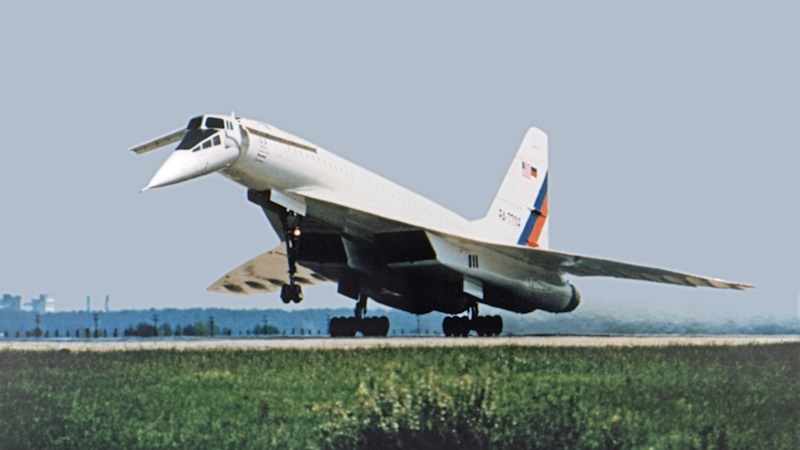
The new engines were Kuznetsov NK-321 low-bypass fan jets, used on the huge Tupolev Tu-160 "Blackjack" bomber, replacing the Tu-144's Kolesov RD-36 engines. The NK-321 provided about 20% more power than the RD-36-51 and still better fuel economy. Each NK-321 had a max dry thrust of 137.3 kN (14,000 kgp / 31,000 lbf) and an afterburning thrust of 245.2 kN (25,000 kgp / 55,000 lbf). The details of the NK-321s were secret, and the Western partners in the venture were not allowed to inspect them.
A sequence of about 26 test flights was conducted in Russia with officials from the NASA Langley center at the Zhukovsky Flight Test Center from 1996 into 1999. Two NASA pilots, including NASA space shuttle pilot C. Gordon Fullerton, flew the machine during the course of the trials. As also discussed in the next section, the whole exercise came to nothing, but it was at least nice to get the machine back in the air one last time.
BACK_TO_TOP* Although the US had given up on the Boeing 2707-300 in 1971, NASA continued to conduct paper studies on SSTs, and in 1985 US President Ronald Reagan announced that the US was going to develop a high-speed transport named the "Orient Express". The announcement was a bit confusing because it blended an attempt to develop a hypersonic spaceplane, which emerged as the dead-end "National Aerospace Plane (NASP)" effort, with NASA studies for an improved commercial SST.
By the early 1990s, NASA's SST studies had emerged as the "High Speed Research (HSR)" effort, a collaboration with US aircraft industries to develop a "High Speed Civil Transport (HSCT)" that would carry up to 300 passengers at speeds from Mach 2 to 3 over a distance of 10,500 kilometers (6,500 miles), with a ticket price only 20% more than that of a conventional subsonic airliner. The NASA studies focused heavily on finding solutions to the concerns over high-altitude air pollution, airport vicinity noise levels, and sonic boom that had killed the 2707-300.
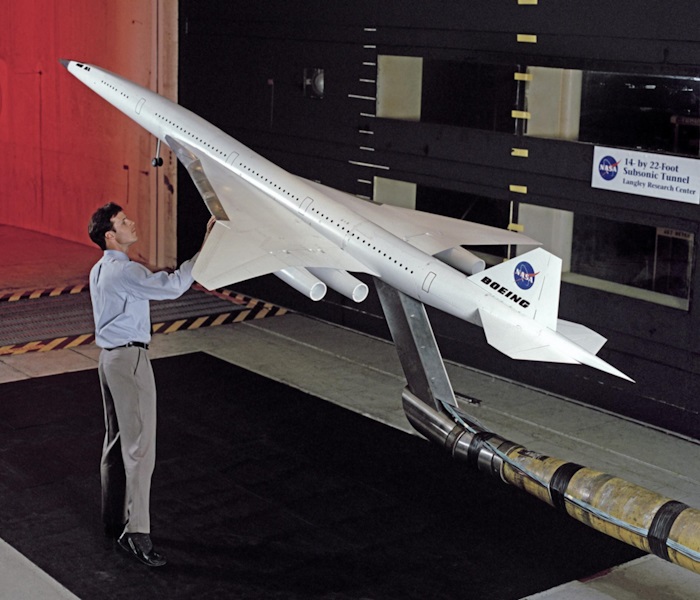
Other nations also conducted SST studies, with Japan flying large rocket-boosted scale models in the Australian outback, and there was an interest in international collaborative development efforts. The biggest non-environmental obstacle was simple development cost. While it might have been possible to develop an SST with reasonable operating costs -- though obviously not as low as those of a subsonic fanjet airliner -- given the high development costs, it was hard to see how such a machine could be offered at a competitive price and achieve the sales volumes needed to make it worthwhile to build.
Some aerospace firms took a different approach on the matter, proposing small "supersonic business jets (SSBJs)". The idea was that there is a market of people who regard time as money and who would be willing to pay a high premium to shave a few hours for a trip across the ocean. Development costs of such a machine would be relatively modest, and the business model of serving a wealthy elite, along with delivering small volumes of urgent parcels in the cargo hold, seemed realistic. Firms such as Dassault in France, Gulfstream in the US, and Sukhoi in Russia came up with concepts in the early 1990s, but the idea didn't go anywhere at the time.
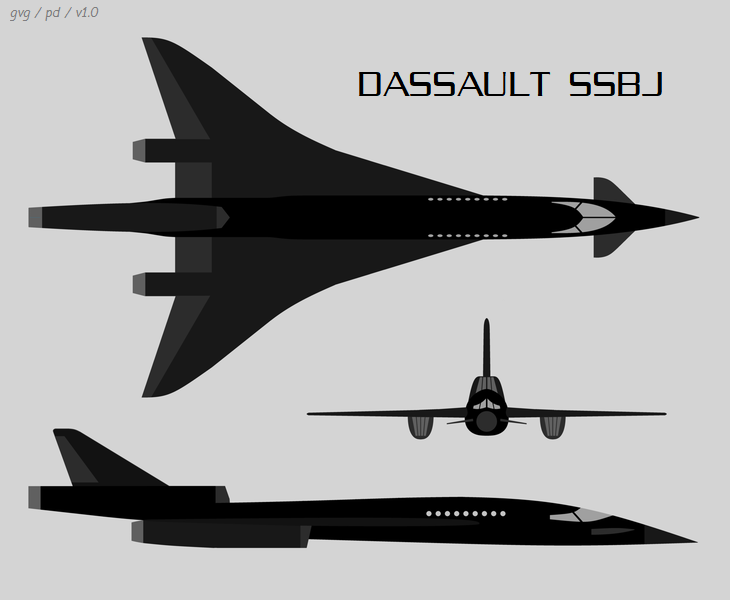
* Although the NASA HSR program did put the Tu-144LL back in the air, the study was finally axed in 1999. NASA, in good bureaucratic form, kept the program's cancellation very quiet, in contrast to the grand press releases that had accompanied the effort. That was understandable, since NASA has to be wary of politicians out to grab headlines by publicly attacking government boondoggles, but in a sense the agency had nothing to hide: NASA studied the matter front to back, and one official stated off the record that in the end, nobody could figure out how to make money on the HSCT. From an engineering point of view, a conclusive negative answer is as useful as a conclusive positive answer -- but few politicians have an engineering background and understand such things.
Some aircraft manufacturers didn't give up on SST research after the fall of the HSCT program. One of the major obstacles to selling an SST was the fact that sonic booms prevented it from being operated at high speed over land, limiting its appeal, and of course an SST that didn't produce a sonic boom would overcome that obstacle. Studies showed that sonic boom decreased with aircraft length and with reduction in aircraft size. There was absolutely no way the big HSCT, which was on a scale comparable to that of the Boeing 2707-300, could fly without generating a sonic boom, and so more recent industry notional configurations envision an SSBJ or small supersonic airliner.
Gulfstream released a notional configuration of a "Quiet Supersonic Jet (QSJ)" that would seat 24 passengers, have a gross take-off weight of 68,000 kilograms (150,000 pounds), a length of 49 meters (160 feet), and swing wings. Gulfstream officials projected a market of from 180 to 400 machines over ten years, and added that the company had made a good profit building machines in productions runs as small as 200 aircraft.
In 2005 Aerion Corporation, a startup in Reno, Nevada, announced concepts for an SSBJ designed to carry 8 to 12 passengers, with a maximum range of 7,400 kilometers (4,000 NMI) at Mach 1.5, a length of 45.18 meters (149 feet 2 inches), a span of 19.56 meters (64 feet 2 inches), and a maximum take-off weight of 45,350 kilograms (100,000 pounds).
The design was technologically conservative in most respects, with no flashy features such as swing wings or drooping nose. It was a dartlike aircraft, with wedge-style wings fitted with long leading-edge strakes, a steeply swept tailfin with a center-mounted wedge-style tailplane, and twin engines mounted on stub pylons on the rear of the wings. It had a fly-by-wire flight control system, and a "glass cockpit" with touchscreen controls.
The wings were ultra-thin, made of carbon composite materials, and featured full-span trailing-edge flaps to allow take-offs on typical runways. The expected power-to-weight ratio at normal operating weights was about 40%, roughly the same as a Northrop F-5 fighter in afterburner. The Aerion SSBJ was to operate efficiently at high subsonic speeds over populated areas, where sonic boom would be unacceptable.
Over less populated areas, it was to fly at Mach 1.2, exploiting atmospheric boundary layers to reflect sonic booms upward, so they didn't reach ground. As an Aerion official put it: "The aircraft understands where it is in relation to the air column ahead of it. It understands temperature gradients, and vertical and horizontal winds, and it creates an algorithm that goes into the flight control laws to ensure the aircraft does not boom -- and, really importantly, with high reliability."
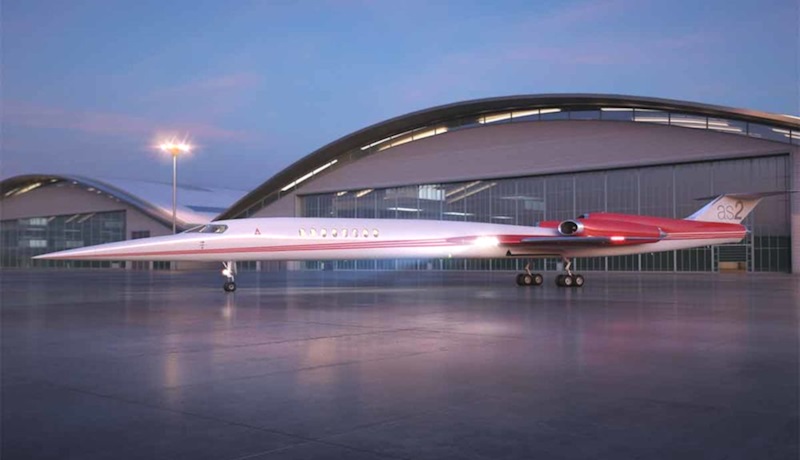
The company opened up the books for orders at the Dubai air show in 2007. The firm established a partnership with Airbus in 2014, with the design then refined and recast as the "Aerion AS2". In 2017, Airbus dropped out, with Lockheed Martin becoming a partner. The company had originally planned to use the existing Pratt & Whitney JT8D engine, but also in 2017, Aerion came to agreement with General Electric to obtain the new "Affinity" engine. In 2019, Lockheed Martin dropped out, with Boeing becoming a partner.
Another aerospace firm, Spike Aerospace, worked on the "Spike S-512", capable of Mach 1.6 and with 18 passenger seats. It was a windowless twin-engine design with no passenger windows, instead featuring panoramic interior displays of the view outside. A third firm, the Boom company, wanted to develop a 45-seat airliner for trans-oceanic flights at Mach 2.2. To that end, Boom built a 1/3-scale, two-seat "XB-1 Baby Boom" demonstrator, powered by twin General Electric J85 afterburning turbojet engines. It performed its initial flight on 22 March 2024, breaking Mach 1 for the first time early in 2025.
In parallel with the work towards a new SST, in 2017, NASA issued a draft request for proposals for development of the "X-59 Quiet Supersonic Transport (QueSST)" low-sonic boom flight demonstrator, with a contract awarded to Lockheed Martin in 2018. NASA conducted sonic-boom flight tests with an F/A-18 Hornet fighter to pave the way for QueSST experiments.
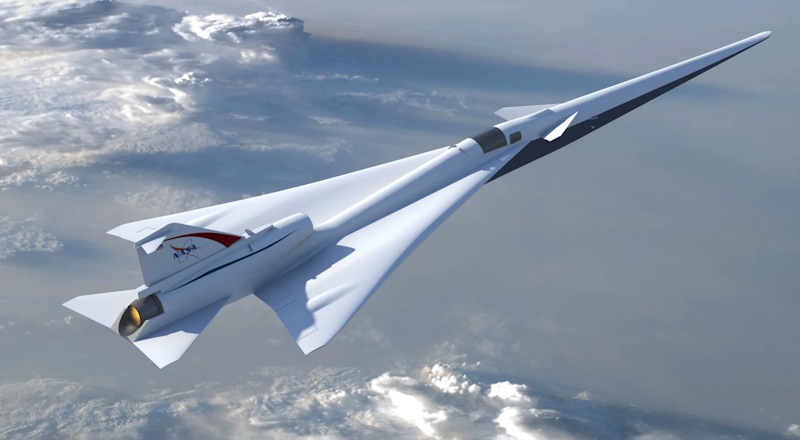
QueSST followed a contract awarded to Lockheed Martin for a preliminary design of a low-boom "Quiet Supersonic Technology (QST)" demonstrator. The X-59 QueSST design was 28.6 meters (94 feet) long and had a wingspan of 8.9 meters (29 feet 5 inches). It was powered by a single engine, at the base of the tailfin, with a sleek shape to reduce shockwave generation, and featured lifting surfaces such as canard, stabilator, and T-tail to further minimize impact points between the airframe and the air, creating fewer shockwaves. Ditching the cockpit windscreen in favor of an electronic vision system eliminated another boom point. The X-59 was to cruise at 16,750 meters (55,000 feet) at Mach 1.42 (1,505 KPH / 935 MPH), creating a mild thump that people might not even notice. Initial flight was supposed to be in 2022, but at last notice it still hadn't flown. Given political instability in the USA from 2025, it may never fly.
* There was so much activity towards an SST that it appeared an SST might return to the air. In early 2021, Aerion countered Boom by announcing plans for a 50-seat SST -- but then, in the spring of 2021, the company abruptly announced that work towards producing the AS2 would stop, because they couldn't get the money needed to fly it. Appearances had been deceiving, with the SST house of cards falling apart again. It seems to be an idea that comes back around every 20 years or so, but runs into the same obstacle: It just doesn't make sense. Spike Aerospace and Boom Technology persisted; as noted, Boom has flown a demonstrator, but nobody is expecting production aircraft any time soon from either company.
Nonetheless, aerospace firms still like to tinker with ideas for even more ambitious jetliners, it appears just to see if anything might be made of them. In 2011, the European Aerospace & Defense Systems group, now Airbus, released a concept for a "Zero-Emissions Hypersonic Transport (ZEHST)" that could carry 50 to 100 passengers from Paris to Tokyo in 2.5 hours. It would be fueled with liquid hydrogen and liquid oxygen, using airbreathing jet engines to get up to Mach 0.8, then combined rocket-ramjet propulsion to get to Mach 4, with the rocket propulsion sustaining the aircraft at cruise speeds at the edge of space.
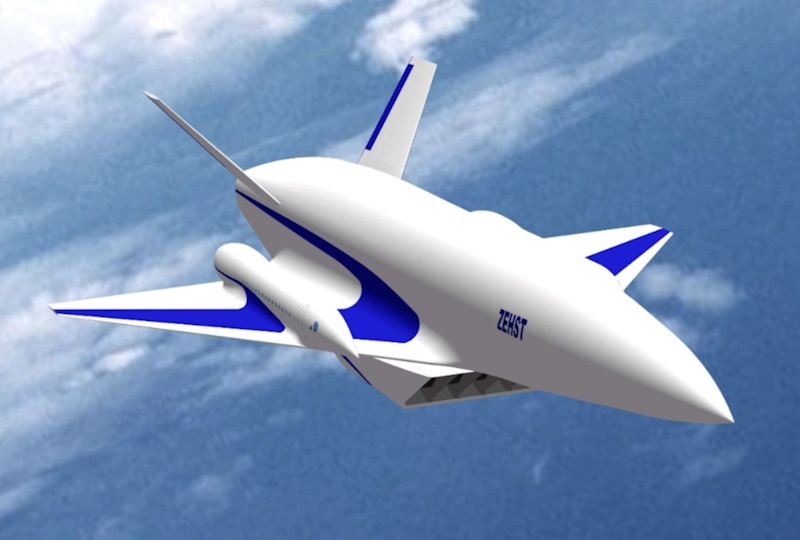
Airbus engineers said ZEHST wasn't an extreme technical challenge, not requiring any development of fundamental new technologies or use of "unobtainium" -- a material whose strength-to-weight ratio or other desired properties tends toward infinity, along with cost -- but even they didn't see it happening before 2040. The European Space Agency worked on a comparable design, the "LAPCAT A2", that would also use combined-cycle hydrogen propulsion to obtain Mach 5 speeds for transoceanic routes, such as Britain to Australia.
It appears that aerospace companies like to tinker with hypersonic aircraft designs as a sheer "blue sky" exercise, possibly with publicity in mind, since there's absolutely no prospect of such vehicles being funded. They pose all the problems of the SST -- sonic boom, high development cost, high operating cost, and environmental concerns -- and compound them. Some have calculated that producing the hydrogen to perform ten flights a day would demand 20% of the UK's electrical power capacity.
There may be a light of sorts at the end of the tunnel in the search for more speed, however. Once notions for high-altitude hypersonic airliners are floated, it's not such a step to envision "single-stage to orbit (SSTO)" spaceplanes that could deliver passengers to a space station in low Earth orbit. Everyone involved in space would like an SSTO spaceliner -- but all work so far in that direction has been an expensive dead end. If it ever happens, it's over the technological horizon.
The push right now is for airliners with improved fuel efficiency, to the extent that older jetliners are often scrapped even when they have plenty of airframe life left in them, simply because they cannot be economically operated; they're more valuable as sources of engine spare parts. There's no quest for speed, and the next generation of energy-efficient jetliners may well be somewhat slower than the current generation.
BACK_TO_TOP* In hindsight, the SST mania that produced the Concorde sounded persuasive at the time, but it suffered from a lack of realism. Although the Concorde was a lovely, magnificent machine and a technological marvel even when it was retired, it was also a testimony to a certain naivete that characterized the 1950s and 1960s -- when people thought that technology could accomplish anything, and set out on unbelievably grand projects. Some of these projects they incredibly pulled off, but some of them turned out very differently than expected. It's still hard not to admire their dash.
There's also a certain perverse humor to the whole thing. The French and the British actually built the Concorde, while the Americans, in typical grand style, cooked up a plan to build a machine that was twice as big and faster -- and never got it off the ground. The irony was that Americans made the right decision when they killed the 2707-300. The further irony was that they did it for environmental reasons that, whether right or wrong, were irrelevant, the significant reality being that they would have lost their shirts on it:
In the modern era, the idea is absurd. It would have been very interesting to have fielded a 12-seat supersonic business jet, a much less challenging proposition from both the technical and commercial points of view, in the 1970s, but people simply could not think small.
* Incidentally, interest in SSTs from the late 1950s through much of the 1960s was so great that most companies that came up with large supersonic combat aircraft also cooked up concepts for SST derivatives. General Dynamics considered a "stretched" derivative of the company's B-58 Hustler bomber designated the "Model 58-9", and the MiG organization of the USSR even came up with an SSBJ derivative of the MiG-25 "Foxbat" interceptor. Of course, none of these notions ever amounted to much more than "back of envelope" designs, or got any further than models.
* Sources include:
The information on the Soviet effort to penetrate the Concorde program was obtained from "Supersonic Spies", an episode of the US Public Broadcasting System's NOVA TV program, released in early 1998. NASA's website also provided some useful details on the Tu-144LL test program and the Tu-144 in general, as did the surprisingly good Russian Monino aviation museum website.
* Illustration credits:
* Revision history:
v1.0.0 / 01 aug 03 v1.0.1 / 01 nov 03 / Cleanup, comments on final Concorde flight. v1.0.2 / 01 dec 03 / Comments on QSP. v1.0.3 / 01 jan 04 / A few minor tweaks on the Concorde. v1.0.4 / 01 feb 04 / Very last flight of Concorde. v1.0.5 / 01 dec 05 / Cosmetic changes, SSBJ efforts. v1.0.7 / 01 nov 07 / Review & polish. v1.0.8 / 01 jan 09 / Review & polish. v1.0.9 / 01 nov 09 / Corrected Paris accident details. v1.1.0 / 01 oct 11 / Review & polish. v1.1.1 / 01 sep 13 / Aerion update. v1.2.0 / 01 aug 15 / General cleanup. v1.3.0 / 01 jul 17 / More on Aerion, NASA QueSST. v1.4.0 / 01 jun 19 / Still more on Aerion & ETC. v1.5.0 / 01 jun 21 / Aerion drops out. v2.0.0 / 01 jun 23 / Illustrations update. v2.1.0 / 01 jun 25 / Review, update, & polish. (!)BACK_TO_TOP
